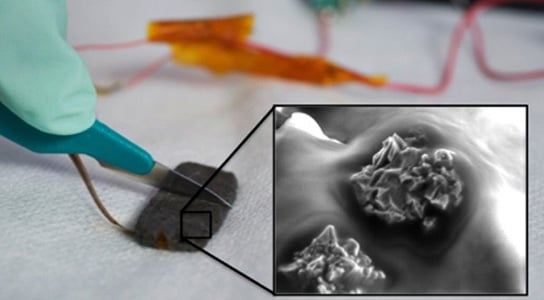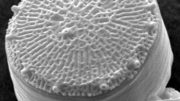
After it was divided with a scalpel, a new polymer was able to heal itself, restoring most of its mechanical and electrical properties in 15 seconds. Credit: Benjamin Tee and Chao Wang
Researchers in California have developed a synthetic version of skin that’s flexible, electrically conductive, and self-healing.
The scientists published their findings in the journal Nature Nanotechnology. There has been a small boom in the last decade in the development of epidermal electronics, thin and flexible circuits that can be attached to skin or provide skin-like touch sensitivity to prosthetic limbs.
Chemists have also become increasingly interested in self-healing polymers, some of which join their cut edges together when they are heated up, when a light is shone on them, or when the edges of the cut are held together.
Zhenan Bao, a chemical engineer at Stanford University in Palo Alto, California, and her team have demonstrated the combination of self-healing polymers and epidermal electronics. Until now, self-healing polymers had to have very low bulk electrical conductivities and would have been of little use in electrical sensors. By incorporating nickel atoms into it, the conductivity of self-healing polymers was increased, allowing electrons to jump between the metal atoms. The polymer itself is sensitive to applied forces of pressure and tension, since such forces alter the distance between the nickel atoms.
The researchers cut the polymer completely through with a scalpel to show that both the mechanical and the electrical properties of the material could be repeatedly restored to their original values after the material had been damaged and healed. After the edges of the cut were held together for 15 seconds, the sample went on to regain 98% of its original conductivity. This could be done over and over again.
Mechanical tension could stretch out the material, producing significant scarring and preventing self-healing. Bao and her colleagues are trying to make the self-healing skin more elastic. “I think it will be very interesting if we can make the self-healing skin elastic,” she says, “because, while it’s currently flexible, it’s still not stretchable. That’s definitely something we’re moving towards for our next-generation self-healing skin.”
Reference: “An electrically and mechanically self-healing composite with pressure- and flexion-sensitive properties for electronic skin applications” by Benjamin C-K. Tee, Chao Wang, Ranulfo Allen and Zhenan Bao, 11 November 2012, Nature Nanotechnology.
DOI: 10.1038/nnano.2012.192









Be the first to comment on "Stanford’s Self-Healing Plastic Skin Could Lead to Improved Prosthetics"